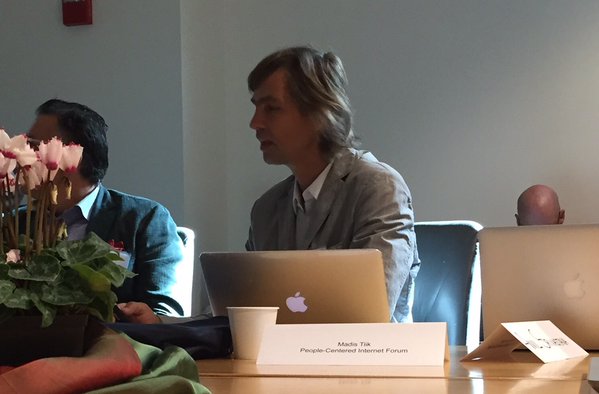
Source: Mark Finnern, via Twitter
The EU eHealth Task Force [1] identified five levers that could create the momentum for a fundamental re-organisation of healthcare to make use of already existing information technologies:
- “My data, my decisions”:patients are the owners and controllers of their own health data, with the right to make decisions over access to the data and to be informed about how it will be used.
- “Liberate the data”: governments should ensure that health data is accurate, reliable, and up-to-date; that it is gathered in a standard way, and anonymised before it is made available to anyone that can add value to it in the best interest of the patient.
- “Connect up everything”: the digital environment is evolving rapidly with an increasing trend of interaction and sharing. Healthcare needs therefore to reap the benefits of the digital age in order to provide more integrated and personalised care to patients rather than “only” interventions.
- “Revolutionise health”: By that we mean creating the necessary conditions for patients to be able to make more informed choices about where and how we want to be treated. This will have real impact on resource allocation in health, as funding follows the patients and not the other way round.
- “Include everyone”: the needs of the vulnerable communities that are outside the reach of eHealth tools need to be accommodated otherwise chances are that eHealth could ultimately exacerbate existing inequalities rather than reducing them.
On the basis of these five levers the Task Force has formulated five recommendations for action to support their vision of health in 2020. These are addressed to policymakers at the European and national levels.



In 1996 Estonia launched Tiger’s Leap project which primary effect was the rollout of Internet access to all Estonian schools, combined with installing modern computer labs in most schools. Tiger’s Leap foundation has organized several other educational projects for different age groups during the years.
In 2002 Estonian Government launched Digital Society roadmap. It declared that by 2012 all public services must be available in digital format. Digital ID and x-road was established and new legislation was adopted to support this goal.
Since then many useful nationwide e-services have been successfully launched and new ones are constantly being developed. To pick a few for example:
e-Tax board is available since 2004,
e-elections started in 2005,
e-health platform launched in 2009,
e-residency launched in 2015,
e-state in the cloud 2016


Current Estonian President Toomas Hendrik Ilves, who was foreign minister in 1996 – was the person who introduced Tiger’s Leap idea to President Lennart Meri, who is another key person behind Estonian transformation to e-Society.
Development of innovative services for citizens has always been in the center of Estonian government policy. We estonians believe that the way to prosperity lies on 3 cornerstones: smart decisions, courage to think differently and taking risks where needed.
Another characteristics for Estonia have been leaders who think out-of-box. These people are domain experts, who are playing key roles in development of new services.

Current Estonian President Toomas Hendrik Ilves, who was foreign minister in 1996 – was the person who introduced Tiger’s Leap idea to President Lennart Meri, who is another key person behind Estonian transformation to e-Society.
Development of innovative services for citizens has always been in the center of Estonian government policy. We estonians believe that the way to prosperity lies on 3 cornerstones: smart decisions, courage to think differently and taking risks where needed.
Another characteristics for Estonia have been leaders who think out-of-box. These people are domain experts, who are playing key roles in development of new services.

In 2005 I was chosen to manage the eHealth Foundation, which is an institution established to lead the digital service development in healthcare. Healthcare was the last sector where Estonia didn’t have any real e-services at that time.
It was decided already in 2002 that all services are using the same secure data exchange layer called X-road and strong authentication mechanisms, like ID card with digital signature.
In one hand it was easier, but on the other hand it took a lot of effort to convince medical professionals to use the same infrastructure that other sectors were already using.
Thanks to using existing infrastructure components, Estonia spent only 10$ per citizen to start digital data exchange between medical professionals, and also give the citizens full control of their data usage.

Explanation of the graph and history of ehealth
Moving from paper records to digital records started early 90ies in Estonia
Logically, the integration was the next move. When the data was released, more insights were needed.
First two stages are mainly costs; benefits are coming after we develop smart services. Integration with other sectors: social, environmental and adding self-collected data by citizens themselves.



In 2011, few years after the integration of healthcare providers electronic records, we realized that this was only the beginning of the change of paradigm in the healthcare sector.
And more important is that this guides us to preventive, predictive, participatory and more personalized care.
2015 Estonia started pilot project of perzonalised medicine. During next year cohort of 50000 gene donors DNA is sequenced and data is integrated with data from medical records, personal health records, social data and environmental data will be added. By the end of 2016 recommendations will be given for the government, how to implement those recommendations in healthcare system in the future.
